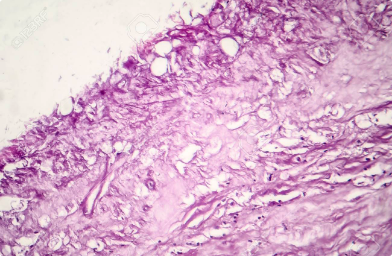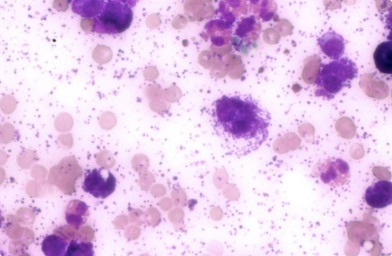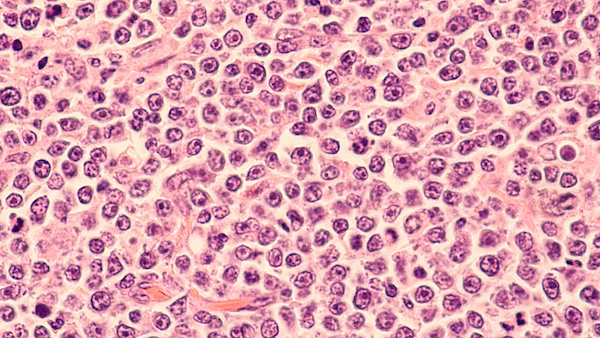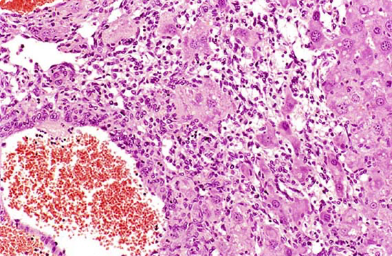Leukemia
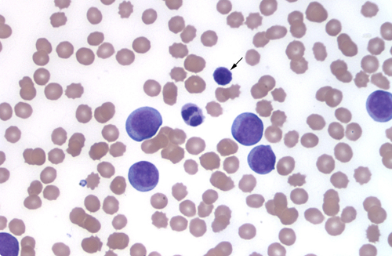
Leukemia develops from cancerous cells originating in the bone marrow which is the site of both red and white blood cell production. There are two major types of leukemia—lymphocytic (lymphoid) or myelogenous (myeloid). Both types of leukemia result from cell divisions in particular blood cells that have gone out of control. Each type is further classified as acute or chronic depending on whether the dysregulation occurs in an early or later stage of blood cell development. Lymphocytic leukemia involves a class of white blood cells called lymphocytes whereas myelogenous leukemia derives from white blood cells other than lymphocytes, as well as platelets and red blood cells.1 Genetic mutations that disrupt cell maturation result in overproduction of the malignant cells which markedly reduces the production of normal cells. Ultimately, this reduces the number of healthy blood cells, weakens the immune system, and increases the dog’s susceptibility to illness.
Although the exact cause of leukemia is unknown, both genetic and environmental factors play a role. The symptoms of leukemia are relatively generic and are often missed. In many cases, the disease is actually detected following the diagnosis of some other illness that the dog has contracted due to its inability to mount a protective immune response. The most common diagnosis comes from routine blood tests revealing that the white blood cells appear distorted or are undergoing abnormal division. These results should be followed by a biopsy or bone marrow aspiration, especially if your dog is lethargic, lacks appetite, or has pale gums and tongue. Since leukemia is a cancer of the blood cells, it can easily move to other organs especially the liver or kidneys.2 It is important to be alert to changes in your dog’s behavior and overall health. Report these changes to your vet as soon as possible. Early detection allows many cases of canine leukemia to be treated effectively and managed so your dog can live a more comfortable life. Treatment can restore blood cell production, reduce symptoms, and relieve discomfort.3
The subdivision of leukemia into major groups is based on both the stage of blood cell development, acute or chronic, as well as the type of blood cell involved, lymphocytic or myelogenous.1 Acute and chronic forms of leukemia are fairly treatable if diagnosed early; however, neither is curable. It is important to realize that the acute form is much more malignant and can lead to a life-threatening condition.2 Acute leukemia involves a very rapid increase in the number of immature blood cells and the overproduction of these abnormal cells crowds out the healthy blood cells produced in the bone marrow. The rampant growth of the malignant cells then spills over into the blood stream and spreads to other organs.4 Chronic leukemia also involves excessive division of blood cells, but with this cancer, it is the accumulation of abnormal mature cells that give rise to the malignancy. Acute leukemia must be treated immediately whereas chronic leukemia is sometimes monitored for some time before treatment to ensure maximum effectiveness of therapy.5
The type of blood cell affected is also used to subdivide the various leukemias. Lymphoid or lymphocytic leukemias originate in white blood cells that normally form lymphocytes from T or B cells. Myeloid or myelogenous leukemias derive from a cancerous change in marrow cells that normally form other types of white cells, platelets, or red blood cells. Combining the classifications provides a total of four main categories for leukemia: Acute lymphocytic, chronic lymphocytic, acute myelogenous, and chronic myelogenous.1
Only the acute versus chronic divisions of canine leukemia will be addressed in the following section.
Acute Leukemia
Acute leukemia arises primarily in the bone marrow and results from genetic mutations that prevent cell maturation and promote cell division. Thus, the rapidly dividing leukemic cells prevent normal cells from developing in the bone marrow. As the leukemic cells accumulate, they spill out of the bone marrow and move to sites such as spleen, liver, and lymph nodes.1 The combination of reduced normal blood cell production and spread of malignant cells can be life threatening. Although the term “acute” applies to the stage of blood cell maturation, myeloid or lymphoid leukemias are also characterized as acute due to their sudden onset and rapid progression. Unfortunately, the acute forms are often rapidly fatal and respond poorly to therapy, particularly myeloid types.1 The average age for developing acute lymphocytic leukemia is 6.2 years, but can occur in dogs even younger than 4 years. This disease progresses very rapidly.6
Symptoms
The most striking symptoms of acute leukemia are bleeding, bruising, increased susceptibility to infections, and delayed healing time. Bleeding and bruising are a result of the reduction in platelets, tiny cells that play a big role in blood since they promote clot formation.3 Susceptibility to infections and delayed healing time are a result of the reduction in white blood cells, the immune system’s first line of defense.4 Insufficient numbers of healthy white blood cells seriously compromise your pet’s capacity to fight infection and to heal. Additional symptoms are listed below:7
- lack of appetite or weight loss
- pale gums
- pale or white color in the tongue
- lethargy
- lameness
Chronic Leukemia
Similar to acute leukemia, chronic leukemia can be lymphoid or myeloid in origin. However, unlike acute leukemia which involves excessive division of immature blood cell types, “chronic” leukemia refers to the increased population of mature cells that are often detected following a routine blood test. The term chronic also provides information with regard to the onset and progression of the disease. Unlike acute leukemia, the chronic forms usually have a prolonged onset and progress slowly.6
It is often more difficult to diagnose chronic leukemia since high blood cell counts may actually be a result of many other disease states. However, a persistent and unexplained increase in white blood cells documented over several months of blood testing is suggestive of chronic leukemia. A presumptive diagnosis should be followed by an intensive diagnostic investigation. Chronic myeloid leukemia is exceedingly rare in animals, and most chronic leukemias originate from the lymphoid lineage.1 Chronic leukemia most often affects older dogs (10-12 years), is typically asymptomatic in the beginning stages, and progresses quite slowly.8
Symptoms
Symptoms of chronic leukemia may not be as easy to spot at first, as the condition can take months or even years to fully develop. Some dogs show no signs at all when they are diagnosed. The condition is often discovered through routine blood work, which is another reason why it is important to get regular check-ups with your veterinarian. Here are a few symptoms that might appear with chronic leukemia which tend to worsen with time:2
- lethargy
- loss of appetite
- anemia (a condition in which you lack enough healthy red blood cells to carry adequate oxygen to body’s tissues)
- swelling in the lymph nodes
- enlargement of the spleen
- ruising or bleeding easily
Although most leukemias develop spontaneously from a mutation in the bone marrow cells,7 there are certain factors that increase the risk of developing this type of blood cancer. These factors include exposure to radiation, certain viral infections, and exposure to toxic chemicals. Because the causes of leukemia in dogs are not known, there is no reliable means of preventing the condition.4
The most common diagnosis of leukemia comes from an irregular blood sample, in which the white or red blood cell counts (or both) seem abnormal. Again, most leukemic patients are often diagnosed by accident during a routine blood test. Usually a valid diagnosis occurs only after your vet conducts a biopsy or bone marrow aspiration. If more than 20-25% of immature blast cells are present in the bone marrow, the diagnosis of acute leukemia is strongly supported. A cut-off of 20% blasts is used for the diagnosis of acute myeloid leukemia with a cut-off of 25% used to distinguish acute lymphoid leukemia which is often confused with another blood cell cancer called lymphoma.4 Since leukemia symptoms are not often obvious, by the time most patients are diagnosed, immature blast cells have increased so rapidly that their numbers dominate all other cells of the bone marrow.
Bone biopsies or aspirates can be painful for the patient and typically require anesthesia for comfort and to prevent moving during the procedure.2 Diagnosis of canine leukemia may also be accomplished using urinalysis and biochemical profiling. To determine if the cancer has spread to other sites in body, the following procedures can also be conducted:4
- Chest and abdominal X-rays
- Abdominal ultrasound
- Fine needle aspirate of abdominal organs or lymph nodes
Your veterinarian can begin to diagnose leukemia in your dog by first observing the clinical signs and discussing their symptom history. However, since this disease may present in a similar way to other diseases, your veterinary specialist will have laboratory tests and imaging assessments done to confirm the diagnosis. Your veterinarian may discover that your dog has a fever and following palpitation, enlarged lymph nodes and enlarged organs in the abdominal area. Pale gums and mucous membranes may also be observed after viewing mouth, nose and eyes.
The initial blood analysis will be carefully evaluated and abnormalities in the number of red and white blood cells, a low platelet count, and the presence of a persistent reduction in red blood cell count (anemia) may be detected. Kidney and liver function also may be assessed following the results of a urinalysis, and an abdominal ultrasound will provide a more detailed view of the organs. Quantitative and qualitative evaluations of a bone marrow aspirate will be conducted and if needed, chest x-rays will be ordered [9]. It is important to distinguish acute leukemia from lymphoma or from more treatable forms of leukemia early since even with aggressive chemotherapy, only 30% of patients achieve remission.6
Although it is rare that leukemia is cured, many cases of canine leukemia can be treated and managed so that your dog can live a more comfortable life.3 Treatment usually restores proper white blood cell production, reduces symptoms, and relieves discomfort. While it does not cure the condition, chemotherapy can put the cancer into remission or slow its growth. If the appropriate chemotherapy is applied, your dog could possibly live for a number of years after remission.8 The goal of chemotherapy in all cases is to achieve remission and allow your dog to remain comfortable for as long as possible. If the condition spreads to other areas of the body, including spleen or lymph nodes, your dog may require stronger treatment.
Patients can normally be treated as an outpatient. However, if low levels of red blood cells, platelets, or other blood clotting factors are detected, your dog should be hospitalized and given blood transfusions to prevent excessive bleeding. Supplements, dietary changes, and alternative medicine will not cure leukemia. However, they can help in strengthening your dog’s immune system, and this feature is extraordinarily important for the body’s own ability to prevent secondary infections during treatment. Be sure to consult your veterinarian to see how these changes in diet or alternative medicines interact with prescribed treatment.9
Acute Leukemia Treatment
Acute leukemia is more likely to be fatal than chronic leukemia, and it requires immediate and aggressive care. Usually this includes intravenous fluids, antibiotics, and blood transfusions if the patient has anemia. A feeding tube may be needed if your dog cannot eat on their own, and a chemotherapeutic protocol involving a combination of drugs will be initiated.9 Some of the recommended chemotherapy drugs for treating acute leukemia are similar to those used for canine lymphomas. These include prednisone, vincristine, cyclophosphamide, L-asparginase and doxorubicin.10
Chronic Leukemia Treatment
Chronic leukemia is typically maintained through careful monitoring. Since the condition progresses slowly, no treatment may be necessary in the beginning stages of the disease. However, you will need to observe your dog closely and record any new symptoms. It is important to bring your dog into a veterinarian’s office for regular physical examinations and blood work to monitor blood cell counts.8 If the disease progresses, you can maintain your dog’s comfort and health by vigilant monitoring in combination with chemotherapy—an approach that can improve and prolong your dog’s life. Dogs with chronic leukemia often survive for up to two years even without chemotherapy, but with treatment, the outcome is even more positive.11
Prognosis for acute leukemia is unfortunately typically very poor even when the most aggressive chemotherapy protocols are used. The CHOP/Madison-Wisconsin10 protocol that involves 16 doses of chemotherapy over 6 months records a response rate of approximately 30% with average survival times of typically less than 2 months. Occasional survivals of greater than half a year have been reported. Acute myeloid leukemias are rare and even less responsive to treatment (median survival time less than 1 month). In contrast, most patients with chronic leukemia do very well with their treatments with high remission rates of up to 90% and average survival times of 1-2 or more years. Owners are typically very happy with their pets’ quality of life.



